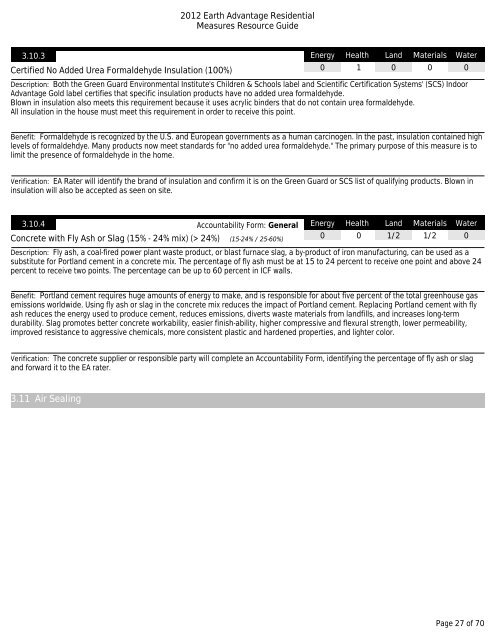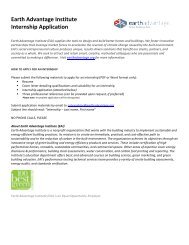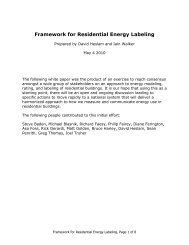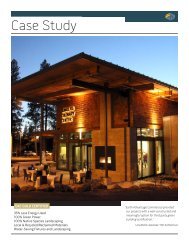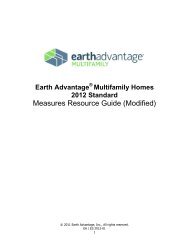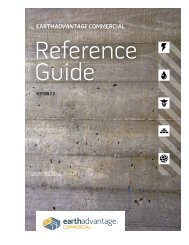EA New Homes Measures Guide - Earth Advantage
EA New Homes Measures Guide - Earth Advantage
EA New Homes Measures Guide - Earth Advantage
Create successful ePaper yourself
Turn your PDF publications into a flip-book with our unique Google optimized e-Paper software.
2012 <strong>Earth</strong> <strong>Advantage</strong> Residential<br />
<strong>Measures</strong> Resource <strong>Guide</strong><br />
3.10.3<br />
Certified No Added Urea Formaldehyde Insulation (100%)<br />
Energy<br />
Health<br />
Materials<br />
Water<br />
0 1 0 0 0<br />
Description: Both the Green Guard Environmental Institute's Children & Schools label and Scientific Certification Systems' (SCS) Indoor<br />
<strong>Advantage</strong> Gold label certifies that specific insulation products have no added urea formaldehyde. <br />
Blown in insulation also meets this requirement because it uses acrylic binders that do not contain urea formaldehyde. <br />
All insulation in the house must meet this requirement in order to receive this point.<br />
Land<br />
Benefit: Formaldehyde is recognized by the U.S. and European governments as a human carcinogen. In the past, insulation contained high<br />
levels of formaldehdye. Many products now meet standards for "no added urea formaldehyde." The primary purpose of this measure is to<br />
limit the presence of formaldehyde in the home.<br />
Verification: <strong>EA</strong> Rater will identify the brand of insulation and confirm it is on the Green Guard or SCS list of qualifying products. Blown in<br />
insulation will also be accepted as seen on site.<br />
3.10.4<br />
Accountability Form: General<br />
Concrete with Fly Ash or Slag (15% - 24% mix) (> 24%) (15-24% / 25-60%)<br />
Energy<br />
Materials<br />
Water<br />
0 0 1/2 1/2 0<br />
Description: Fly ash, a coal-fired power plant waste product, or blast furnace slag, a by-product of iron manufacturing, can be used as a<br />
substitute for Portland cement in a concrete mix. The percentage of fly ash must be at 15 to 24 percent to receive one point and above 24<br />
percent to receive two points. The percentage can be up to 60 percent in ICF walls.<br />
Health<br />
Land<br />
Benefit: Portland cement requires huge amounts of energy to make, and is responsible for about five percent of the total greenhouse gas<br />
emissions worldwide. Using fly ash or slag in the concrete mix reduces the impact of Portland cement. Replacing Portland cement with fly<br />
ash reduces the energy used to produce cement, reduces emissions, diverts waste materials from landfills, and increases long-term<br />
durability. Slag promotes better concrete workability, easier finish-ability, higher compressive and flexural strength, lower permeability,<br />
improved resistance to aggressive chemicals, more consistent plastic and hardened properties, and lighter color.<br />
Verification: The concrete supplier or responsible party will complete an Accountability Form, identifying the percentage of fly ash or slag<br />
and forward it to the <strong>EA</strong> rater.<br />
3.11 Air Sealing<br />
Page 27 of 70


